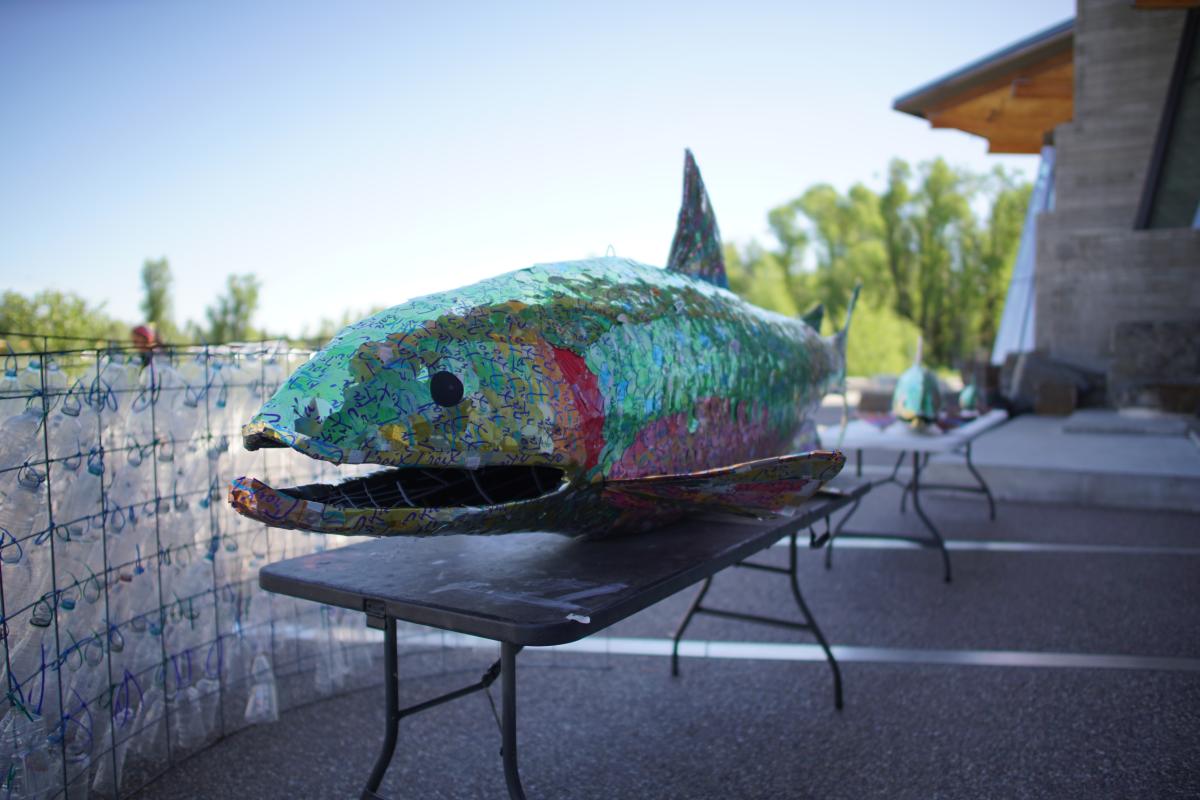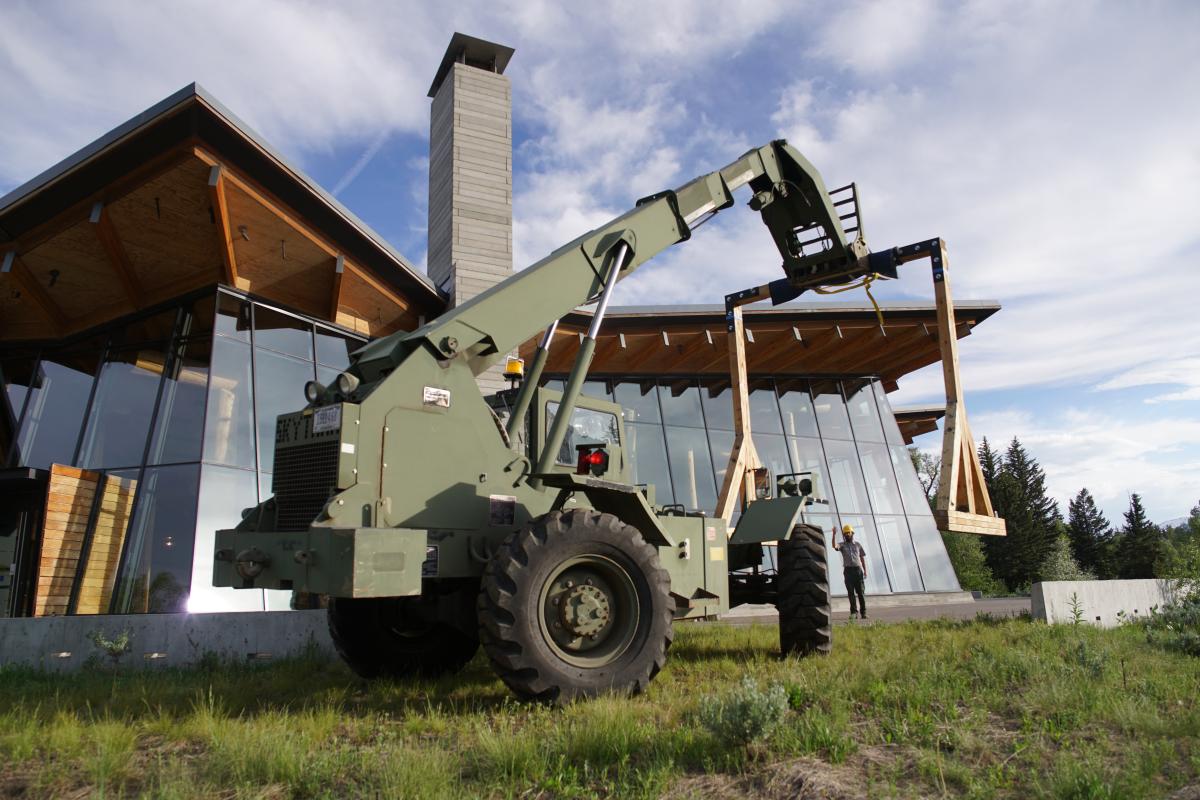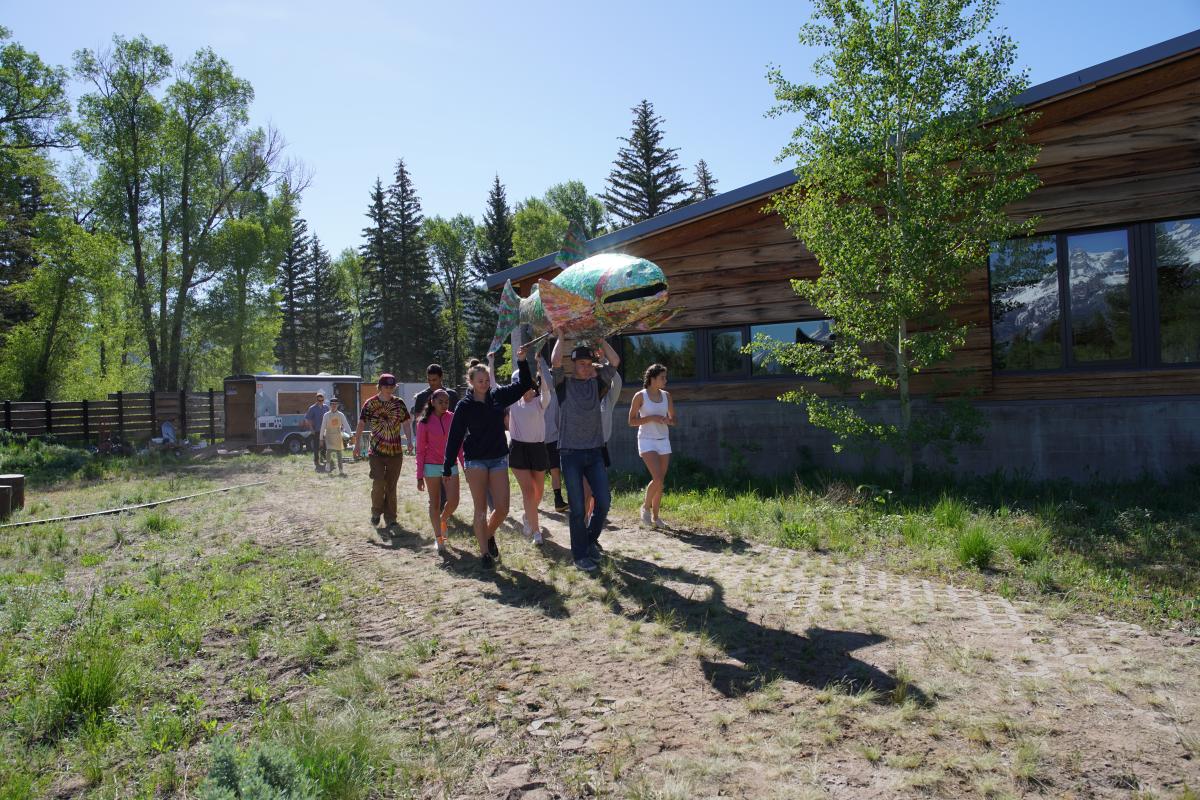High School Recycling Design Challenge Yields Innovative Results For Subaru and Grand Teton National Park’s Zero Landfill Project
July 11, 2017 /3BL Media/ - Student designers are helping to inspire recycling in Grand Teton National Park thanks to a visionary program titled, Building STEAM. This program is led by Jackson Hole Public Art in partnership with Grand Teton National Park and Teton County School District, and funded by Subaru of America, Inc. as part of its Zero Landfill Initiative. Through this initiative, Subaru shares its knowledge of zero landfill practices with the national parks and works towards a goal of significantly reducing waste going into landfills.
Led by Jackson Hole Public Art’s professional artist-on-staff, Bland Hoke, students in Jackson Hole High School’s Fabrication Lab have installed two public art projects at the Craig Thomas Discovery Center in Grand Teton National Park. The overarching goal of their installations is to improve the park’s waste diversion rate and facilitate easier collection, while communicating to a diverse audience that recycling can be fun. Over 100,000 visitors will see the temporary artworks titled “STREAM” and “Mountain Recycling Bin” on display through the month of July.
The large-scale STREAM (Science, Technology, Recycling, Engineering, Arts, Math) project is 25 feet high by 45 feet long. STREAM is suspended from two gantries built from repurposed wood that support a flowing stream of recycled water bottles and shimmering rainbow trout coated with La Croix can scales, the largest trout is 6 feet long. This project visualizes the 2016 recycling diversion rate, comprised of materials collected for recycling and materials disposed of in the waste stream. Outside on the terrace, a sculptural river flows overhead depicting the materials not collected for recycling. Inside, a smaller portion of material depicts the ratio of materials collected for recycling.
“My favorite thing about this project is that I am making something that revolves around art and design instead of my first idea of just making a different type of recycling bin. I’ve started thinking outside the box and have found a way to show how recycling can be turned into a very fun and alluring piece of art. It shows the public that the materials they recycle can be used to create something that you wouldn’t expect.”
– Raegin, Student at Jackson Hole High School
Mountain Recycling Bin is fabricated out of steel in the shape of three Teton peaks, each with a clear window that displays three commonly collected recycled materials; glass, aluminum and #1 plastic. To address the problem of contamination by mixing materials, the students chose to showcase the recycled materials in an engaging way. Using hammers and blenders, they processed glass, plastic and aluminum into different sized particles and filled a container with the smallest particles on the bottom and recognizable recycled materials at the top of the mountain. The result depicts geologic time and the compression of material. The design solves the challenge of communicating how to properly recycle across languages by showing what materials can be recycled.
“Our favorite thing about this project is how it makes people think about and understand that they can make a choice when they go and recycle their materials in the park.” – Ashley, Vinny, Gage, Gus, Students at Jackson Hole High School
The Building STEAM project took several months to realize. Starting in December 2016, students conducted research, participated in site visits, and held stakeholder interviews. After the first phase, Bland Hoke taught students the Stanford University’s Design Thinking Process to evolve their concepts into solutions that ranged from practical to conceptual. The students then created prototypes and tested various solutions, culminating in the development of highly innovative final design concepts. In March 2017, eight student teams presented their concepts to a panel of Subaru, Grand Teton National Park, and National Parks Conservation Association staff that selected two final projects to build. Students then spent the final months of school fabricating their designs with professional guidance from Bland Hoke in order to achieve a high level of quality and ensure that local engineering standards were met.
The creative partnership between Subaru, Grand Teton National Park, Teton County School District and Jackson Hole Public Art equipped students with in-depth knowledge of the waste stream in the National Park and Teton County, and engaged students as ambassadors of the park.
Jackson Hole Public Art’s Building STEAM program introduces students to a variety of professions and equips them with the ability to develop a concept from design into production through a collaborative, creative problem-solving process that can be replicated in any future profession they choose to work in. Building STEAM projects empower students to use art, design, and technology to address current issues in a proactive way.
ABOUT SUBARU OF AMERICA, INC.
Subaru of America, Inc. (SOA) is a wholly owned subsidiary of Subaru Corporation of Japan. Headquartered at a zero-landfill office in Cherry Hill, N.J., the company markets and distributes Subaru vehicles, parts and accessories through a network of more than 620 retailers across the United States. All Subaru products are manufactured in zero-landfill production plants and Subaru of Indiana Automotive, Inc. is the only U.S. automobile production plant to be designated a backyard wildlife habitat by the National Wildlife Federation. SOA is guided by the Subaru Love Promise, which is the company’s vision to show love and respect to everyone, and to support its communities and customers nationwide. Over the past 20 years, SOA has donated more than $120 million to causes the Subaru family cares about, and its employees have logged more than 40,000 volunteer hours. As a company, Subaru believes it is important to do its part in making a positive impact in the world because it is the right thing to do.
For additional information visit media.subaru.com. Follow us on Facebook, Twitter, and Instagram.
Diane Anton, Corporate Communications Manager
Subaru of America, Inc.
danton@subaru.com I 856.488.5093 I media.subaru.com
ABOUT GRAND TETON NATIONAL PARK
Grand Teton National Park and John D. Rockefeller, Jr. Memorial Parkway, units of the National Park Service, preserve 333,700 acres in northwest Wyoming for future generations. Visitors enjoy the Teton Range, pristine lakes, the Snake River, the valley of Jackson Hole, and the wildlife that call these places home. Visit www.nps.gov/grte or follow at www.Facebook.com/GrandTetonNPS, www.twitter.com/GrandTetonNPS, www.instagram.com/grandtetonnps, and www.flickr.com/photos/grandtetonnps.
Denise Germann, Public Affairs Officer
(307) 739-3393 | denise_germann@nps.gov
ABOUT JACKSON HOLE HIGH SCHOOL’S FABRICATION LAB
The Jackson Hole High School Digital Fabrication Lab started in the fall of 2013 with 100 students. The FabLab is a creative space for students to engage in the design thinking process where they solve problems using collaboration, prototyping, and high tech tools found in makerspaces.
Sammie Smith, Director of JHHS Digital Fabrication Lab
Jackson Hole High School
ssmith@tcsd.org | 307-732-3775 | www.jhhsfablab.com
ABOUT JACKSON HOLE PUBLIC ART
Jackson Hole Public Art forges partnerships for the integration of art into any environment, to inspire lasting cultural, educational and economic benefits. Jackson Hole Public Art’s Building STEAM program was formed two years ago by artist-on-staff Bland Hoke to introduce high school students to community issues ripe for creative problem-solving. Learn more at www.JHPublicArt.org.
Carrie Geraci, Executive Director
carrie@jhpublicart.org | 307-413-1474 | www.jhpublicart.org




